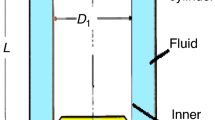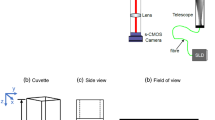Abstract
An experimental study was conducted to visualize the flow field and confirm the transitional Reynolds number from laminar to turbulent flow, as distilled water flows through quartz glass microtubes with inner diameter 315 and 520 μm. With gentian violet as colorant, the flow field pictures in the microtube, and therefore, is shot by a CCD camera with a microscope at different Reynolds numbers. Pressure drop data were also used to characterize the friction factor for those microtubes in the Reynolds number range of 200–2300. The experimental results clearly showed that the flow in the microtube was the laminar state and the friction factors agreed well with the Poiseuille equations when the Reynolds number was low. As the Reynolds number was larger than 1200 and 1500 for the microtube with inner diameter 315 and 520 μm, respectively, the friction factor departed from the classical laminar solution due to the earlier transition from laminar to tubulent flow. The flow turned into full turbulent when the Reynolds number reached 1500–1800.
Similar content being viewed by others
References
Wang, B. W., Peng, X. F., Experimental investigation on forced flow convection of liquid flow through microchannels. Int. J. Heat Mass Transfer, 1994, 37(suppl. 1): 73–82.
Peng, X. F., Peterson, G. P., Wang, B. X., Heat transfer characteristics of water flowing through microchanels. Exp. Heat Transfer, 1994a, 7: 265–283.
Peng, X. F., Peterson, G. P., Wang, B. X., Frictional flow characteristics of water flowing through microchannels, Exp. Heat Transfer, 1994b, 7: 249–264.
Mala, G. M., Li, D., Flow characteristics of water in microtubes, Int. J. Heat and Fluid Flow, 1999, 20: 142–148.
Li, Z. X., Du, D. X., Guo, Z. Y., Investigation on the characteristics, Proc. Symposium on Energy Engineering in the 21st Century, 2000, 2: 658–664.
Li, Z. X., Du, D. X., Guo, Z. Y., Experimental study on flow characteristics of liquid in circular microtubes, in Proceedings of the International conference on Heat Transfer and Transport Phenomena in Microscale. Banff, Canada, 2000, 162–-167.
Li, Z. X., Du, D. X., Z. Guo, Y., Experimental study on flow characteristics of liquid in circular microtubes, Microscale Thermophysical Engineering, 2003, 7: 253–265.
Celata, G. P., Cumo, M., Zummo, G., Thermal-hydraulic characteristics of single-phase flow in capillary pipes, Experimental Thermal and Fluid Science, 2004, 28: 87–95.
Li, Z. H., Zhou, X. B., Zhu, S. N., Flow characteristics of non-polar organic with small molecules in microchannel. Acta Mechanica Sinics (in Chinese), 2002, 34(3): 433–437.
Qu, W. L., Mala, G. M., Li, D. Q., Pressure-driven water flows in trapezoidal silicon microchannels, Int. J. Heat and Mass Transfer, 2000, 43: 353–364.
Author information
Authors and Affiliations
Corresponding author
Rights and permissions
About this article
Cite this article
Liu, Z., Zhao, Y. Experimental study on visualization of the flow field in microtube. Sci. China Ser. E-Technol. Sci. 48, 521–529 (2005). https://doi.org/10.1360/04ye0312
Received:
Revised:
Issue Date:
DOI: https://doi.org/10.1360/04ye0312




